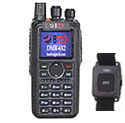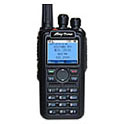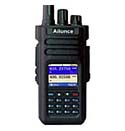|
TDMA Tier I vs Tier II John 'Miklor' K3NXU |
| TDMA / Time Slots Time Division Multiple Access. |
Tier I and Tier II radios are not compatible. They are two separate digital designs that were never meant to play together. Below is a brief summary as to why.
Tier I
Tier I radios are used primarily in the European UHF license free band. Although the signal is digital, they are not to be used on a Tier II DMR repeater. A Tier 1 only radio consumes the entire bandwidth, much like FM or Analog,
 |
With TDMA Tier II, the signal is divided into alternating 30ms slices known as Time Slots. This allows two signals to interweave on the same frequency, so two different conversations can actually take place independently at the same time.
The graphic below shows the splitting of a transmitted digital signal into these 30ms time slices (Time Slots).
The code plug’s Time Slot (TS) parameter determines which path you will be using, TS1 or TS2.
 |
Tier I Interference
Because of their different structures, a Tier I radio should not be used on a Tier II DMR TDMA repeater system.
Some radios are advertised as "Time Slot 1" only. This is Not a Tier II radio. A radio with only one Time Slot (TS1) will blanket a Dual Time Slot system, covering up TS2, creating interference on the repeater network.


Terminology Confusion
If a radio has only one Time Slot, this is a continuous carrier Tier I radio. It is not compatible and should never be used on a Tier II DMR network to prevent interference on the network.
A radios Tier II capability is determined by its hardware. A radio incorporating HR-C3000 / RDA1846 cannot support Tier II, regardless of firmware and software. These Tier I radios will, however, work on simplex between other Tier I radios.
Below is a Short list of radios to avoid for Ham repeater use. There are others, but these have been confirmed as digital, but not Tier II compatible.
| Baofeng |
DM-5R &
DM-5R Plus are
both Tier I RD-5R and DM-5R V3 2018 are Tier II |
|
| Baofeng | DM-8HX | |
| Baofeng | GT-3 DMR Mk IV | |
| Radioddity | GD-55 GD55+ is Tier II | |
| TYT | MD-398 | |
| TYT | MD-680 | |
| Retevis | RT-81 | |
| Radtel | RT-14D (dPMR) | |
| Radtel | RT-43 (dPMR) | |
|
|
|
|
|









